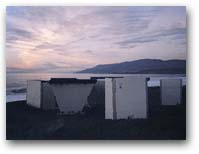 Profiler Network site on the coast of California contributes to a better understanding of weather and air quality. |
Water Cycle Branch
Dr. F. Marty Ralph, Lead
The Water Cycle Branch combines an extensive suite of sensors with expertise on basic physical processes affecting weather and climate, observing system capabilities and deployment, numerical modeling, and forecasting techniques. This team of 30 people, including 13 scientists and 9 engineers, conducts research focused on improving the understanding and prediction of a variety of phenomena that span the interface of weather and climate and that are of particular importance to NOAA and to society, e.g., precipitation processes and forecasting, the relationship between short-term climate variability and significant weather events, and meteorological influences on air quality. The group has extensive experience with design and use of regional networks of ground-based and airborne remote sensors, conventional in-situ observations and satellite data. These have been used in major NOAA efforts (e.g., HOA, WRF model development, USWRP's PACJET experiment), and have created close ties with other NOAA labs and with the NWS (NCEP, WFOs, and RFCs) and growing ties with NESDIS (CIRA and CIMSS).
The Branch maintains and deploys many instruments, including 15 wind profilers with RASS and surface stations, several sodars, 2 vertically pointing S-band radars, 2 scanning radars (X and K-bands), flux and soil moisture systems, ceilometers, a tethersonde, GPS sounding systems and other equipment. Engineering advances focus on adapting equipment for use in extreme environments and on improving automation and reliability.
The Branch's deployments are used to explore basic physical processes, to document the capabilities and limitations of existing and candidate new observing systems, and to develop new forecasting techniques for a variety of applications. Key applications include improving predictions of coastal weather, developing tools to assist air quality, water, and energy resource managers, quantifying air-sea interaction processes, and resolving tropical and polar processes affecting mid-latitude weather. Such problems demand an observational and analysis approach that spans time scales from hours to seasons, and uses the group's ability to design, deploy, and assess regional observing networks. The Branch has developed an end-to-end approach from the development, refinement, and assessment of new observational tools, to the execution of process studies, and finally, to linking to end users. In short, the Division has demonstrated the ability to link NOAA research and operations to meet NOAA's customers' needs.
The Branch's capabilities and goals are epitomized by its leadership of the CALJET and PACJET experiments, which address the goals of NOAA in USWRP, and by co-leadership with CDC and NCEP/CPC of the Climate-Weather Connection initiative. The group is experienced in the NOAA Initiative process, including co-leadership of the Coastal Storms and Climate Weather Connection Initiatives ( FY02 and FY03), and involvement in the successful Climate Observations and Services Initiative (FY01). It is currently leading, with the NWS, the development of a NAOS-triggered initiative (NWS-OAR) for FY04 aimed at improving regional observing networks nationwide by linking researchers, forecasters and forecast users based on the CALJET/PACJET experience in ways that address the Climate-Weather Connection and USWRP's goals for identifying an optimal mix of observations for weather prediction.
